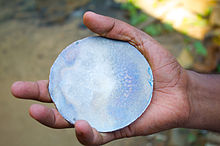Aranmula Kannadi


Aranmula kannadi (Template:Lang-ml, meaning the Aranmula mirror) is a handmade metal-alloy mirror, made in Aranmula, a village in the state of Kerala, India. Unlike the normal 'silvered' glass mirrors, being a metal-alloy mirror, it is a front surface reflection mirror, which eliminates secondary reflections and aberrations typical of back surface mirrors. The exact metals used in the alloy are unknown to people and is maintained as a Vishwakarma (Template:Lang-ml) family secret; however metallurgists suggest the alloy to be a mix of copper and tin. It is then polished for several days in a row to achieve their reflective surface.[1] They are considered one among the eight auspicious items or “ashtamangalyam” that makes up the entry of the bride at the venue of the wedding. These unique metal mirrors are the result of Kerala's rich cultural and metallurgical traditions, and have great historical and cultural value and are even considered to bring good luck.[1] Produced by a single extended family in Aranmula, the origins of the Aranmula kannadi are linked with the Aranmula Parthasarathy Temple. Legend has it that eight families of experts in temple arts and crafts were brought by the royal chief to Aranmula from Tirunelveli district to work in the Parthasarathy temple centuries ago on the mirrors.
The British Museum in London has a 45 centimeter tall Aranmula metal mirror in its collection.[1] The mirrors have received a geographical indication (GI) tag in 2004-05.[2]
See also
References
- ^ a b c "Aranmula mirrors". The Hindu. Kollam, India. 2012-07-13.
- ^ "STATE WISE REGISTRATI ON DETAILS OF G.I APPLICATIONS". India. 2004-05. Retrieved 13 June 2013.
{{cite web}}: Check date values in:|year=(help)
External links
![]() Media related to Aranmula kannadi at Wikimedia Commons
Media related to Aranmula kannadi at Wikimedia Commons
